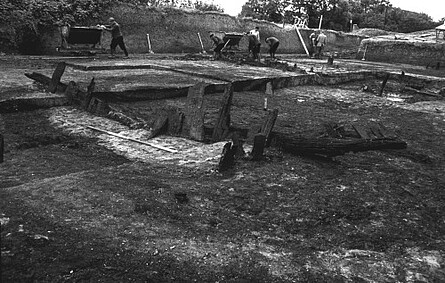The Early Medieval Settlement on the Wurt mound of Hessens within the City of Wilhelmshaven
The early medieval Wurt Hessens is located on the southwestern periphery of Wilhelmshaven between the railway line to Sande and the Ems-Jade Canal. Even though the immediate environs of the Wurt were used as spoil ground during harbour construction, the Wurt mound, covering an area of approximately 2 ha, remains visible as a slight elevation in the terrain. The site was excavated by the NIhK under the direction of W. Haarnagel and W. Reinhardt between 1939 and 1963. The finds and context documentation were the subject of detailed analysis by Dr. Annette Siegmüller within the scope of her doctoral dissertation at the University of Hamburg. The project under the direction of W. H. Zimmermann was funded by the Lower Saxony Ministry for Science and Culture (MWK) between 2005 and 2007. Analysis of the excavation documentation resulted in far-reaching insights into settlement development and economy within the salt marsh between the 7th and 10th centuries AD. The outstanding preservation conditions within the waterlogged soil environment of the Wurt mound are particularly noteworthy as they preserved organic materials like wood, feathers and textiles up to the point of excavation.
The excavation area uncovered four continuously occupied farm plots arranged around an open square. The open area comprised a large dew pond and a well with a shaft constructed from clay sods, both of which are presumed to have been utilised by the entire community. A massive 7th-century timber structure was recorded within the dew pond; during the course of excavation and subsequent analysis this has attracted a variety of interpretations, ranging from palisaded rampart to animal trough. Based on ethnographic comparisons and a detailed analysis of the finds assemblage the researcher concluded that the installation was a plunge for washing sheep in order to obtain – as much as possible – clean wool. High quality sheep wool was one of the most important export articles of the marsh dwellers.
The development over the course of the 7th century of one farm plot with access to a navigable creek is also of particular interest. Here it was possible to document the conversion from three-aisled house with byre to boat house with slipway, suggesting an increase in the exchange of goods by boat.
Bibliography
Siegmüller, A., Bungenstock, F. (2011): Der Anschluss der Wurt Hessens an gezeitenbeeinflusste Wasserwege und die Nachweise für Schifffahrt. Siedlungs- und Küstenforschung im südlichen Nordseegebiet 34, 2011, 321-331.
Siegmüller, A, (2010): Die Ausgrabungen auf der frühmittelalterlichen Wurt Hessens in Wilhelmshaven. Siedlungs- und Wirtschaftsweise in der Marsch. Studien zur Landschafts- und Siedlungsgeschichte im südlichen Nordseegebiet 1. Rahden/Westf.
Siegmüller, A. (2007): Eine frühmittelalterliche Schafwaschanlage auf der Wurt Hessens, Wilhelmshaven - Überlegungen zur Wollverarbeitung im Nordseeküstenbereich und ihrer Bedeutung für die Definition der friesischen Tuche. In: F. Andraschko u.a. (Hrsg.), Archäologie zwischen Befund und Rekonstruktion. Ansprache und Anschaulichkeit. Festschrift für Prof. Dr. Dr. hc Renate Rolle zum 65. Geburtstag, Hamburg, 205-214.
Siegmüller, A. (2007): Peek, C., u. Siegmüller, A., 2007: Kostbarkeiten aus dem Norden? Neue Überlegungen zur Identifizierung Friesischer Tuche. Archäologisches Korrespondenzblatt 37, 2007, 283-296.


